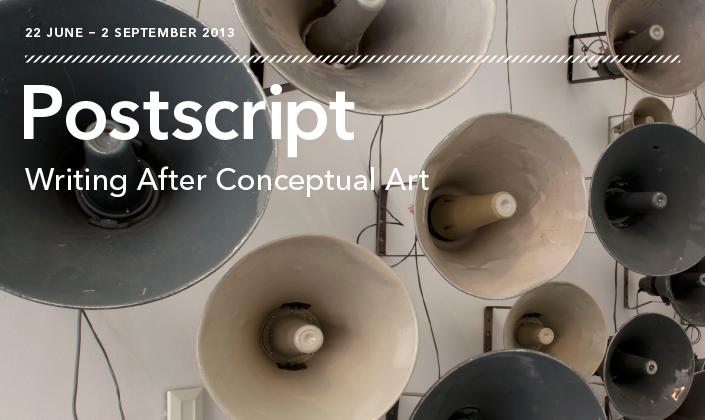The Power Plant is proud to present Postscript: Writing After Conceptual Art, featuring paintings, sculpture, installation, video and works on paper from the 1960s to the present by over fifty artists and writers exploring the artistic possibilities of language.
ARTISTS
Mark Amerika & Chad Mossholder, Carl Andre, Fiona Banner, Erica Baum,
Derek Beaulieu, Caroline Bergvall, Jen Bervin, Jimbo Blachly & Lytle Shaw, Christian Bök, Marcel Broodthaers, Pavel Büchler, Luis Camnitzer, Ricardo Cuevas, Tim Davis & Robert Fitterman, Monica de la Torre, Craig Dworkin, Tim Etchells, Ryan Gander, Michelle Gay, Kenneth Goldsmith, Dan Graham, Alexandra Grant, James Hoff, Bill Kennedy & Darren Wershler, Seth Kim-Cohen, Sol LeWitt, Glenn Ligon, Tan Lin, Gareth Long, Michael Maranda, Helen Mirra, Jonathan Monk, Simon Morris, João Onofre, Michalis Pichler, Paolo Piscitelli, Vanessa Place, Kristina Lee Podesva, Seth Price, Kay Rosen, Joe Scanlan, Dexter Sinister, Frances Stark, Joel Swanson, Nick Thurston, Triple Canopy, Andy Warhol, Eric Zboya
CURATED BY NORA BURNETT ABRAMS AND ANDREA ANDERSSON, MUSEUM OF CONTEMPORARY ART DENVER
Postscript: Writing After Conceptual Art is a group exhibition featuring the work of more than fifty Canadian and international artists and writers. It is the first exhibition to examine the work of conceptual writing, investigating the roots of the movement in the art of the 1960s and 70s and presenting contemporary examples of text-based art practices. The Power Plant brings Postscript to the gallery to explore the place of language within contemporary art and broadly examine its relationship to history.
Postscript includes a selection of writing by Conceptual artists of the 1960s that were specifically distributed in traditional codex form. The contemporary conceptual writing filling the galleries includes paintings, drawings, prints, 16mm films, digital video, photographs, mixed-media sculpture, sound installations, and iPad applications; the historical works on view are distinguished by their increasingly obsolete bound structure. For an exhibition full of copies – of found and reproduced texts, of visual and literary art that mimic one another and echo works from preceding generations – the book binding introduces questions about the role of disciplinary specificity in contemporary reading and writing practices.
The historical works in this exhibition are examples of text-based art generated through practices of appropriation, transcription, translation, redaction, and constraint. The contemporary works on view borrow these same strategies, and in many cases, turn the strategies back onto historical works of literature and art. Postscript brings together different generations and different disciplines to demonstrate that works that look alike can still signify differently.
